Introduction
Similarly to endoscopic sinus surgery, cadaver dissection represents a fundamental step for anatomical studies and surgical training in endoscopic ear surgery. The complete absence of bleeding facilitates the detailed visualization of even the smallest structures, allowing as well the simulation of surgical procedures that will be reproduced in living patients. In the following we suggest a procedure for endoscopic cadaveric ear dissection, described step by step.1,2 After middle ear dissection, approaches to the internal ear and internal auditory meatus are also described.3,4 Most of the dissections are performed using a 0° endoscope, while 45° optics are mostly used to visualize the retrotympanum (see all figures in this chapter).5–7
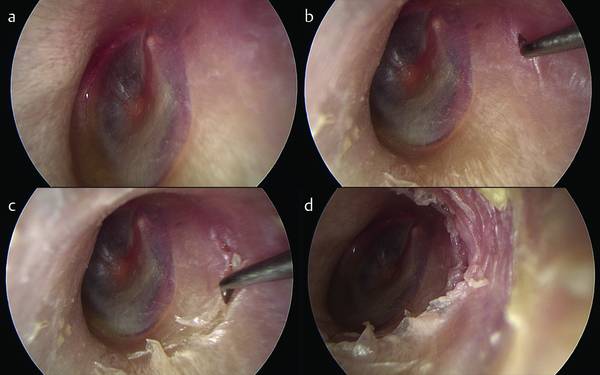
Fig. 9.1 a Preliminary endoscopy to evaluate the external auditory canal (EAC) dimensions and shape, and to evaluate accessibility. b–d The EAC skin is incised with a round knife from the 11 o’clock to the 6 o’clock positions, the surgeon trying to feel the bone under the cutting edge of the instrument.

Fig. 9.2 a The skin of the EAC is gently dissected with an elevator, from lateral to medial, the surgeon trying to avoid tearing. Generally elevation starts in the posterior and inferior portion of the EAC. b The elevation proceeds to the most superior portion of the EAC. An anteriorly based flap is so obtained. c, d The Prussak space is visualized, by the elevation of the most medial and superior portion of the EAC and the pars flaccida. Special attention must be paid in pars flaccida dissection: with forceps the pars flaccida is pulled inferiorly, interrupting the weak adhesions to the short process of the malleus. Special attention must also be paid to maintaining the integrity of the posterior ligament of the malleus. dr, eardrum. plm, posterior ligament of the malleus; pos, posterior spine; mlf, malleolar ligamental fold; prs, Prussak space.
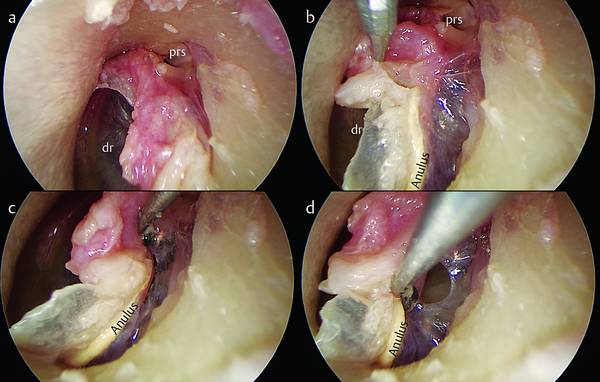
Fig. 9.3 a The medial aspect of the Prussak space is visualized. b, c The fibrous anulus is visualized and elevated from its bony insertion. d The mucosa of the middle ear is identified and incised to access the middle ear cavity. prs, Prussak space; dr, eardrum.
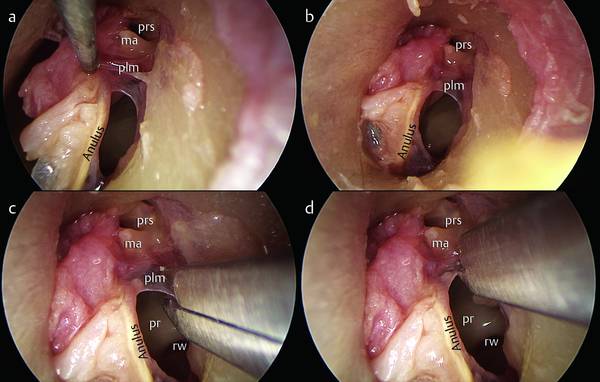
Fig. 9.4 The posterior ligament of the malleus is visualized (a, b) and dissected with scissors (c, d) so as to free the flap and carry on its dissection. ma, malleus; prs, Prussak space; plm, posterior ligament of the malleus; pr, promontory; rw, round window.
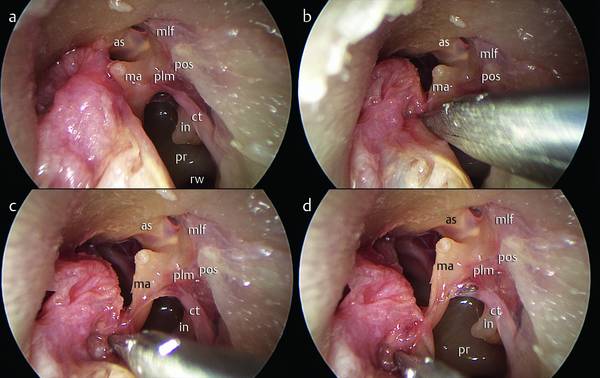
Fig. 9.5 To complete the flap elevation, the handle of the malleus must be freed from its adhesion to the eardrum (a, b). This can be achieved by pulling the eardrum using a Hartmann forceps, or by dissecting it with a hook, or, in a living patient, by the use of a Vesalius instrument. The dissection of the handle of the malleus is carried out from superiorly to inferiorly, and the most anterior portion of the eardrum is elevated (c, d). During these steps the eardrum is left adherent to the umbus. ma, malleus; prs, Prussak space; plm, posterior ligament of the malleus; pr, promontory; rw, round window; in, incus; as, anterior spine; mlf, malleolar ligamental fold; ct, chorda tympani; pos, posterior spine.
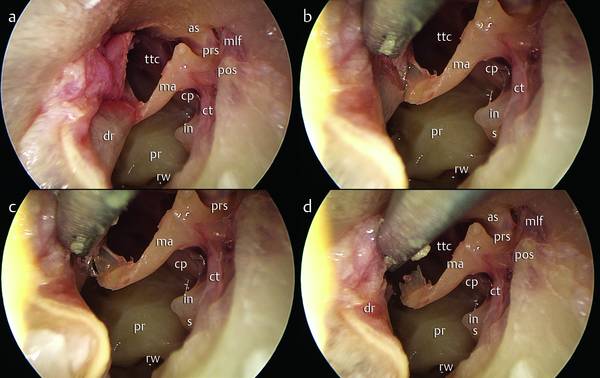
Fig. 9.6 The tympanomeatal flap, now based only inferiorly, is pendunculized on the umbus (a). Its connections with the umbus are then sectioned to completely free the tympanomeatal flap from the malleus handle (b–d). In this way the eardrum is placed on the inferior aspect of the EAC, allowing adequate access to all the parts of the tympanic cavity by the endoscopic approach. ma, malleus; prs, Prussak space; pr, promontory; rw, round window; in, incus; as, anterior spine; mlf, malleolar ligamental fold; ct, chorda tympani; s, stapes; cp, cochleariform process; ttc, tensor tympani canal; dr, eardrum; pos, posterior spine.
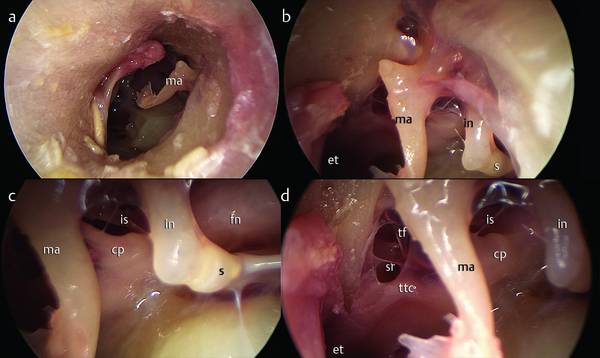
Fig. 9.7 a The middle ear medial aspect is now fully visualized. b A closer view of the protympanic space and eustachian tube. c A closer view of the isthmus region. d A closer view of the tensor fold area (from below). In this particular patient the tensor fold is complete, having a vertical orientation. The supratubal recess inferiorly to the inferior aspect of the tensor fold area can be clearly identified. ma, malleus; in, incus; s, stapes; et, eustachian tube; fn, facial nerve; tf, tensor fold; sr, supratubal recess; is, tympanic isthmus; ttc, tensor tympani canal; cp, cochleariform process.
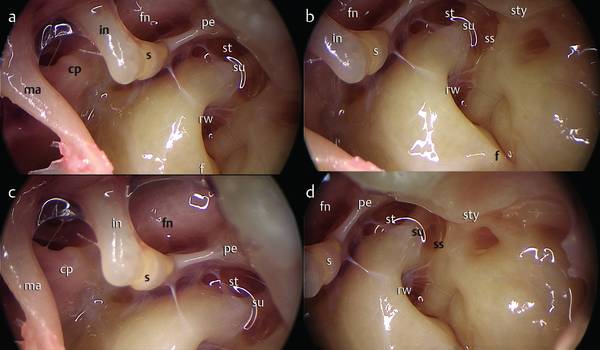
Fig. 9.8 a–d The retrotympanum and round window region is explored thoroughly with the use of 0° and 45° optics. pe, pyramidal eminence; sty, styloid process; ma, malleus; fn, facial nerve; s, stapes; su, subiculum; ss, sinus subtympanicus; cp, cochleariform process; st, sinus tympani; rw, round window; in, incus.
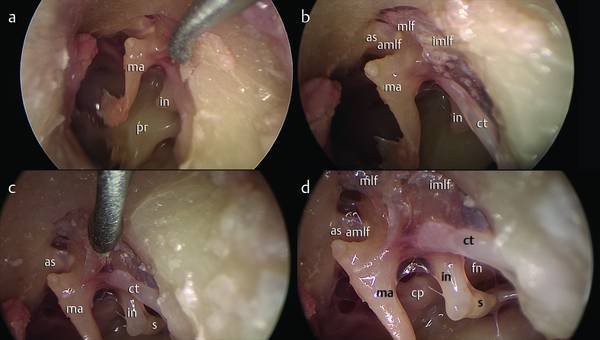
Fig. 9.9 A lateral atticotomy is performed with the use of a bone curette, to better visualize the Prussak space anatomy. Bone tissue in the most superior and posterior portions of the Rivinus notch is removed, and all the folds and ligaments are identified (a–d). ma, malleus; as, anterior spine; mlf, malleolar ligamental fold; amlf, anterior malleolar ligamental fold; ct, chorda tympani; in, incus; s, stapes; fn, facial nerve; pr, promontory; imlf, lateral incudomalleal fold.
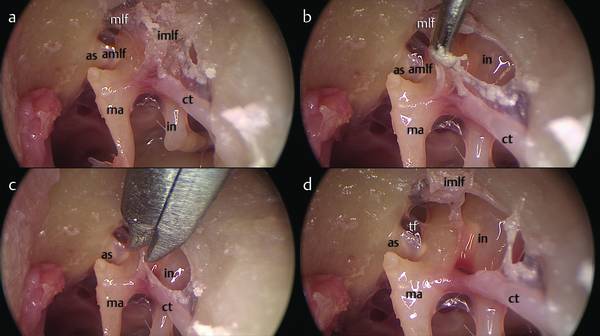
Fig. 9.10 The lateral incudomalleal fold is sectioned in its lateral insertion (a) and then elevated (b) and removed with the aid of scissors (c). Then the malleolar ligamental fold is elevated and the incudostapedial joint is visualized (d). Through these maneuvers, access to the superior and lateral epitympanum and to the superior aspect of the tensor fold is obtained. ma, malleus; as, anterior spine; mlf, malleolar ligamental fold; amlf, anterior malleolar ligamental fold; ct, chorda tympani; in, incus; s, stapes; fn, facial nerve; tf, tensor fold; imlf, lateral incudomalleal fold.
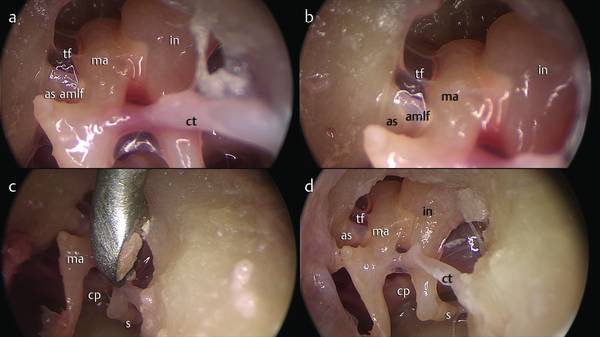
Fig. 9.11 A closer view of the incudomalleolar joint (a), and of the anterior epitympanic space (b). A further widening of the lateral atticotomy is performed, in a posterior direction (c), so as to clearly visualize the short process of the incus and the posterior incudal ligament (d
Stay updated, free articles. Join our Telegram channel

Full access? Get Clinical Tree


